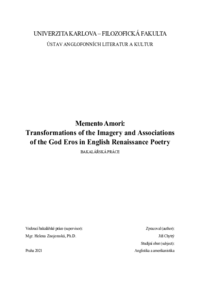Memento Amori: Transformations of the Imagery and Associations of the God Eros in English Renaissance Poetry
Memento Amori: Proměny ikonografie a významových asociací postavy Eróta v anglické renesanční poezii
bakalářská práce (OBHÁJENO)

Zobrazit/
Trvalý odkaz
http://hdl.handle.net/20.500.11956/150278Identifikátory
SIS: 234547
Kolekce
- Kvalifikační práce [24991]
Autor
Vedoucí práce
Oponent práce
Beran, Zdeněk
Fakulta / součást
Filozofická fakulta
Obor
Anglistika - amerikanistika
Katedra / ústav / klinika
Ústav anglofonních literatur a kultur
Datum obhajoby
7. 9. 2021
Nakladatel
Univerzita Karlova, Filozofická fakultaJazyk
Angličtina
Známka
Velmi dobře
Klíčová slova (česky)
Eros|Thanatos|Antika|Renesance|Sonet|Poezie|Láska|SmrtKlíčová slova (anglicky)
Eros|Thanatos|Antiquity|Renaissance|Sonnet|Poetry|Love|DeathPráce se zabývá motiv Eróta ve vztahu ke konceptu smrti v anglické renesanční poezii. Klade si za cíl mapovat systematické proměny metaforiky a konceptuálních asociací spojených s Erótem a Thanatem. Zaměřuje se především na literaturu, zejména na tradici sonetů, s přihlédnutím rovněž k dobovému výtvarnému umění. Mapuje proměny napříč řecko-římskou antikou, zejména zkoumá díla Hesioda, Sapphó a Ovidia, potom skrz renesanci, kde se zaměřuje na básně Cavalcantiho a Petrarchy a závěrem se obrací na Alžbětinskou dobu, kde analyzuje sonety Thomase Wyatta, Sira Philipa Sidneyho, Edmunda Spensera, Micheala Drytona a Samuela Daniela.
The thesis aims to explore the motif of Eros in relation to the concept of death in English Renaissance poetry. Focusing predominantly on literature, namely the sonnet tradition, but also on period corresponding visual art, the paper attempt to map the systematic transformations of the imagery and conceptual associations of Eros and Thanatos. It traces the changes and transformations firstly throughout the Greco-Roman Antiquity, exploring the works of Hesiod, Sappho and Ovid, then from antiquity to the Renaissance, focusing on Cavalcantis' and Petrarch's poetry and ultimately turning to the Elizabethan era, analysing the sonnets of Thomas Wyatt, Sir Philip Sidney, Edmund Spenser, Michael Drayton and Samuel Daniel
